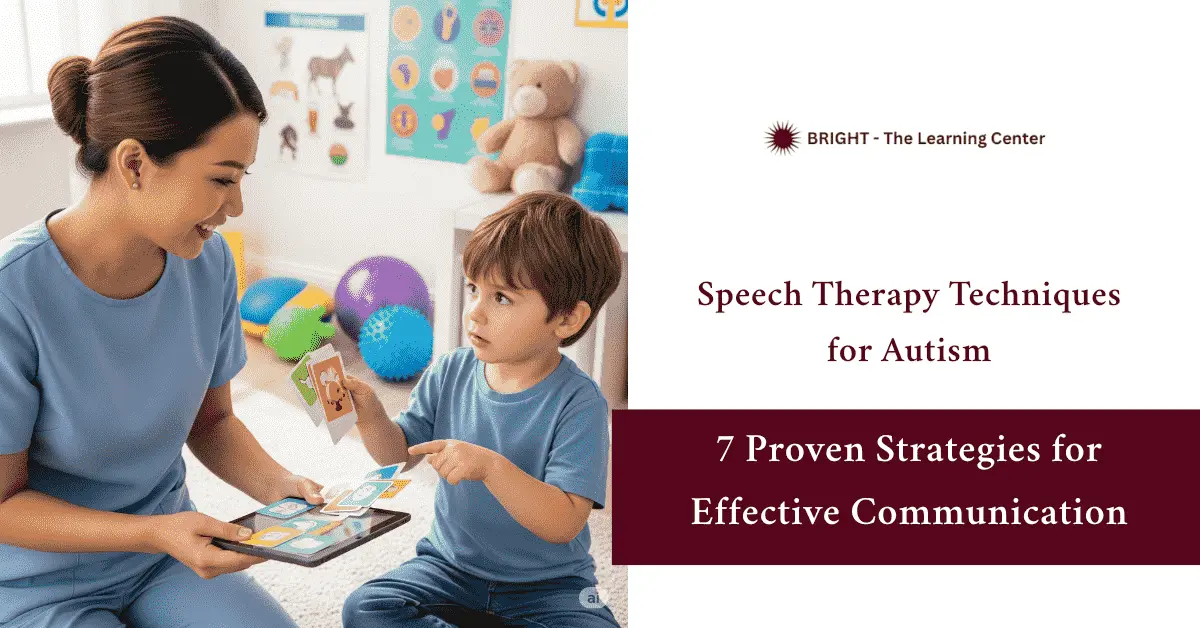Speech therapy techniques for autism are essential tools that help improve communication skills in individuals on the spectrum. These methods address speech delays, social interaction, and language development, providing practical strategies for meaningful connection and everyday success. Explore the key approaches and benefits below.
Table of Contents
Speech Therapy Techniques for Autism: A Quick Overview
Speech therapy techniques for autism aim to build clear communication by targeting speech, comprehension, and social skills. These methods—structured and goal-oriented—support expressive and receptive language growth. Therapists assess individual needs and apply tools like verbal prompts, visual aids, or AAC devices. By addressing language barriers early, these strategies reduce frustration and improve daily interaction. Whether verbal or nonverbal, each learner progresses through methods that meet their abilities. In short, speech therapy techniques for autism bridge gaps in connection, offering functional skills for real-world communication.
Early Support and Social Skill Development
Speech therapy techniques for autism often begin with early support to develop foundational social skills. Early action matters—delays in social interaction can widen over time. Therapists use methods such as:
- Structured turn-taking games
- Eye contact and gesture modeling
- Emotion recognition through visuals
- Scripted role-play for basic conversations
These targeted activities teach children how to connect meaningfully with others. Applied early, speech therapy techniques for autism make daily interactions more natural and communication more confident.
Tools for Nonverbal and Limited Speech Communication
Speech therapy techniques for autism include specialized tools that support individuals with limited or no verbal speech. When words don’t come easily, communication doesn’t have to stop. Therapists introduce alternative systems to bridge the gap between thought and expression.
Common tools include:
- AAC devices (apps or tablets that generate speech)
- PECS (Picture Exchange Communication System)
- Sign language and natural gestures
- Visual schedules and symbol boards
These tools give individuals a reliable voice. With consistent use, speech therapy techniques for autism help build confidence, reduce frustration, and enable real-world communication.
Core Language and Fluency Techniques
Speech therapy techniques for autism target core language development and speech fluency to improve both understanding and expression. Many individuals on the spectrum struggle with forming sentences, retrieving words, or speaking smoothly—this is where structured intervention steps in.
Effective techniques include:
- Articulation drills to refine sound production
- Echoic modeling to build verbal imitation
- Sentence-building exercises to expand expressive language
- Pacing strategies to manage rate and rhythm of speech
Through repetition and structured practice, speech therapy techniques for autism help transform hesitant speech into clearer, more confident communication. Individuals struggling with both speech delays and fluency challenges may benefit from exploring speech therapy for stammering, which focuses specifically on managing repetition, blocks, and rhythm disruptions during speech.
Therapist Selection and Home Practice Strategies
Speech therapy techniques for autism are most effective when guided by the right professional and reinforced consistently at home. Selecting a skilled speech-language pathologist (SLP) isn’t just a formality—it shapes progress.
Look for therapists with:
- Certification in speech-language pathology
- Experience with autism-specific interventions
- A collaborative, measurable approach
At home, progress continues through:
- Daily language routines
- Visual supports for communication
- Practice of specific speech targets from therapy
By aligning professional guidance with everyday reinforcement, speech therapy techniques for autism deliver lasting, functional improvements across settings.
FAQs on speech therapy techniques for autism
What are the techniques of speech therapy for autism?
Speech therapy techniques for autism include articulation drills, social skills training, use of AAC devices, PECS, language-building exercises, and fluency shaping. These methods focus on improving verbal and nonverbal communication tailored to individual needs.
How can I do speech therapy at home for autism?
At home, use simple strategies like consistent daily routines, interactive reading, modeling clear speech, encouraging gestures, and practicing communication targets set by the therapist. Visual supports and positive reinforcement are key.
How to improve an autistic child’s speech?
Improvement comes through regular therapy sessions combined with patient practice at home, focusing on expanding vocabulary, practicing sounds, encouraging social interaction, and using tools like picture cards or apps.
What age do autistic kids talk?
There’s no fixed age—some autistic children speak at typical ages, while others may develop speech later or use alternative communication methods. Early intervention can help accelerate speech development.
What is the best therapy method for autism?
No single best method exists; effective therapy combines approaches like ABA, speech therapy techniques for autism, occupational therapy, and behavioral interventions based on individual needs.
What tools are used for speech therapy?
Tools include AAC devices (speech-generating apps), PECS cards, visual schedules, sign language, and interactive software. These tools support both verbal and nonverbal communication development.

